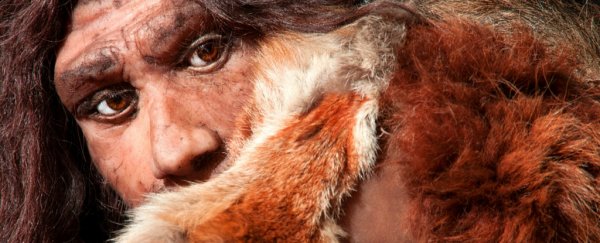By the standards of the Paleolithic age, members of Homo neanderthalensis were the height of sophistication.
These ancient hominins ranged across Europe and parts of Asia for more than 300,000 years, producing tools, jewelry and impressive cave creations. They cared for their sick and elderly. They perhaps even performed a primitive kind of dentistry.
But then Homo sapiens showed up, and the Neanderthals disappeared. So what happened?
For decades, modern human scientists assumed there must have been something wrong with the Neanderthals - or something right with us - that led to their extinction.
Maybe H. neanderthalensis had bad genes that made the species more vulnerable to disease. Maybe the climate changed quickly and they couldn't adapt.
Maybe modern humans were smarter, more innovative, better at coming up with new ways to control territory and secure food. Acres of ancient archaeological sites have been excavated and libraries of academic journals filled by scientists seeking an explanation.
"It's like everyone is searching for 'just so' stories about why one species led the other to extinction," said Oren Kolodny, an evolutionary biologist at Stanford University.
But Kolodny wondered: What if there is no "just so" explanation?
In a paper published Tuesday in the journal Nature Communications, Kolodny and his colleague Marc Feldman test a more basic hypothesis - that the extinction of the Neanderthals was simply a consequence of population dynamics and bad timing.
In most cases, it turned out, this was enough to account for the disappearance of our hominin cousins.
Neanderthals first emerged in Europe around 400,000 years ago. After evolving in Africa, anatomically modern humans arrived in Europe.
There was a brief period of time, between about 51,000 and 39,000 years ago, when H. neanderthalensis and H. sapiens shared the landscape - maybe fighting, and definitely interbreeding. But at the end of that era only one species was left standing.
The speed of replacement led scientists to assume that modern humans had some selective advantage - a trait that made them and their offspring more evolutionarily successful than their cousins.
Initially, Kolodny was interested in calculating the size of that advantage. To do so, he had to establish what's known as the "null hypothesis."
"It's the simplest model that we can build without assuming any hard-to-prove claims, like selection or environmental change," Kolodny explained. In other words, "What do I expect would have happened by default?"
Using what researchers already know about ancient hominin population sizes, migration patterns, and the way ecology works, Kolodny and Feldman built a simple computer model that would simulate Neanderthal and Homo sapiens interactions in Paleolithic Europe.
At the start of the simulation, Europe is inhabited by "bands" of Neanderthals that randomly move around and die out. Every so often, a band of modern humans migrates out of Africa and joins the European fray.
Bands from each species have equal likelihoods of displacing the other - neither one had an advantage from a natural selection perspective.
Kolodny knew that one species had to go extinct at the end of each simulation. It's a basic principle of ecology: Two species cannot occupy the same niche at the same time.
Sometimes, species will accommodate competition by developing some kind of specialty - for example, in parts of Israel where two similar species of normally nocturnal mice are found, one species adjusts by becoming active during the day.
But hominins are generalists, not specialists, and at the time of Neanderthals' extinction, archaeological evidence suggests their abilities and behavior were pretty similar to ours.
Kolodny and Feldman ran their simulation hundreds of thousands of times, changing the values for a number of different variables to reflect the uncertainty that scientists have about this period of human history.
But in the vast majority of cases, under a wide range of parameters, the simulation ended with Neanderthals dying out within 12,000 years.
They just couldn't keep up with the slow trickle of human bands that flowed continuously north from Africa.
This result suggests that the "null hypothesis" - based solely on what we know about basic ecology principles and the gradual human migration into the continent - is sufficient to explain why the Neanderthals disappeared.
It doesn't necessarily prove that humans didn't have a selective advantage, or that climate change didn't influence the Neanderthals' fate, Kolodny cautioned.
"But even if there were no selection and no climate change, the end result would have been the same. It's a subtle distinction but it's important."
Wil Roebroeks of the University of Leiden in the Netherlands told the Associated Press that this study fits with other research that aims to understand the Neanderthals' demise without suggesting humans had an evolutionary leg up on our cousins.
It's common to think of evolution as a series of battles between species. How can you not, with terms like "survival of the fittest" and "evolutionary arms race" sprinkled throughout biology textbooks?
But in nature, creatures aren't making strategic decisions to win an evolutionary war. They're just trying to ensure their own existence.
The fates of individuals and of species are determined by chance - the gradual accumulation of a fluke of genetics, a quirk of timing, a lucky draw of the evolutionary cards.
In the case of our species, modern humans happened to have the deck stacked in their favor.
Kolodny likened this perspective to that of a football fan who, after watching her favorite team win the Super Bowl, finds out that the game had been rigged from the outset.
It doesn't mean that her team didn't play well, but it should change how she feels about the game.
"It's not that Neanderthals were these brutish, wide-shouldered, sort of advanced apes that roamed the land until we came over and beat them," Kolodny said. "It's more that it was a companion hominin species that was very similar to us."
Indeed, it's conceivable that their fate could have been ours.
2017 © The Washington Post
This article was originally published by The Washington Post.
